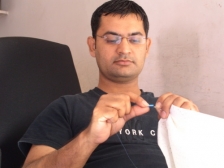Free Shipping On All Orders in the USA
A. Jabbar Khatri
Kutch, India
 SPECIALTIES
SPECIALTIES
- Bandhani textiles
It is impossible to say when Bandhani textiles were first created in India. Mordant dyeing was known around 2000 BC in the ancient Indus Valley city of Mohenjo-Daro. It is possible that resist tie and dyeing was also practiced there. Tie and dye textiles were excavated from a 4th century AD tomb along the northern Silk Road in Astana, in the northwest province of Xinjiang, China. The needle holes and wrinkled texture is still evident. The techniques may have found their way to India along ancient trade routes.
The word "bandhani" is drived from the Hindi word Bandhan which means tying up. These exquisite works of art are traditional textiles from Gujurat and Rajasthan areas of Northwest India. The world's foremost bandhani masters are the Khatri people who live in the Kutch area of Gujurat.
Abdul Jabbar Khatri is a designer and master dyer whose family has been engaged in design, tying and dyeing of bandhai textiles for many generations. His work has been recognized by UNESCO with its Seal of Excellence for Handicrafts Award, both in 2006 and 2007.
After drawing the design on a stencil and transferring it on to the cloth, the unique bandhani tying process begins with the artist using the ring finger of the non-dominant hand to push up from underneath the fabric so as to easily pinch, gather and hold a bit of cloth using the index finger and thumb of the other hand. This finger has a long sharp natural nail or may be capped with a pointed thimble to help in raising a cone of fabric. Then a glass tube is used to feed off the thread smoothly and speedily around and around the gathered fabric. When it is fully covered, a knot is tied at the tip with the help of the middle finger. For bandhani tying, Jabbar employs about 300 artisans from 20 villages in the Kutch district. Most, but not all, of the tyers are women. Unfortunately, they rarely see the end result of their artistry. Depending on the intracacy of the design, the size of the textile, the skill of the tyer, and demands of other household chores, it may take days to months to complete one textile.
After tying is completed, the dyeing process begins. First the cloth is subjected to a mordant solution to ensure even take-up of the dye, then a natural or chemnical dye may be used. This involved process requires an extensive knowledge of color balance and skills in dyeing that takes years to master.
 (866) 228-3497
(866) 228-3497
CUSTOMER SERVICE | SHIPPING | RETURNS | TERMS & CONDITIONS | PRIVACY POLICY
Copyright © 2016 All RIghts Reserved







